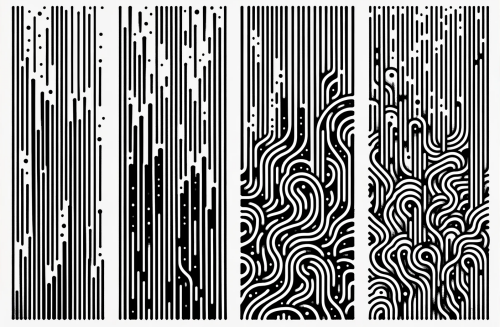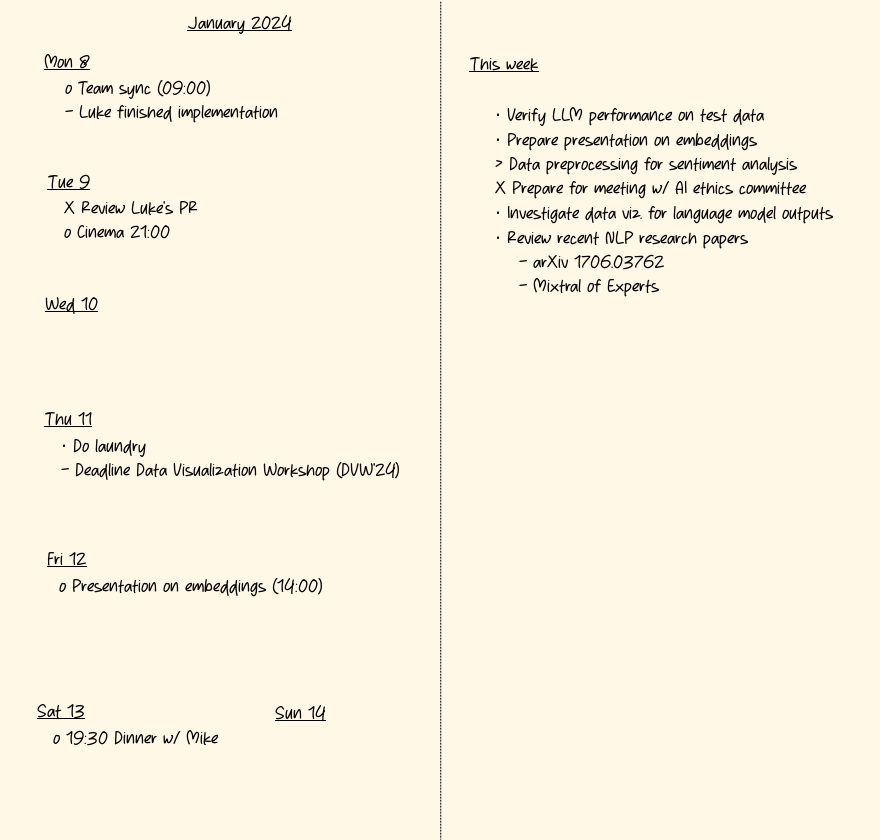Some notes on how I stay organized
12 Jan 2024

David Allen, the creator of the “Getting Things Done” (GTD) method, famously said:
“Your mind is for having ideas, not holding them.”
Long before that, Albert Einstein expressed a similar thought:
“Paper is to write things down that we need to remember. Our brains are used to think.”
These observations resonate with me – it’s easy to get overwhelmed if you have too many reminders, events and ideas in your head all fighting for your attention. My solution has been to follow their advice and dump all those things on pieces of paper, freeing up my head for thinking.
Not that anyone asked, but in this post, I’ll briefly outline the system I’ve been using for a few years to stay on top of my todo lists and ideas.
Introduction
I’ve always been a keen note taker. However, for a long time, it was a disorganized array of tasks, notes and ideas haphazardly jotted down without any structure. Naturally, these would disappeared within the pages of notebooks, never to be found again. I still kept writing things down though because the alternative – keeping everything in my head – would quickly surpass my mental abilities.
A year or two into my PhD studies, I came across the Bullet Journal method and it changed my approach fundamentally. I won’t recap the system here – the best introduction is probably to read Ryder Carroll’s book, but there’s also a multitude of resources on the internet that you can use to get an idea of how it works (see the caveat in the next paragraph though). Having used the method for more than half a decade, there are a few lessons I’ve learned and some annoyances I’ve found workarounds for.
A problem when starting out with the method, or when trying to understand how people use it in practice, is that much of the content about the method published online is very aesthetically-focused – a majority of YouTube videos and blog posts discussing the system showcase notebooks filled with stickers, colored drawings and other embellishments. These things are not at the core of the method – they’re an extra layer that some people find rewarding as a creative outlet – and they can act as an opaque distraction for someone seeking a purely functional system. Apart from Carroll’s book, there are some online resources for “plain and focused” notebooks (e.g., the BasicBulletJournals subreddit).
I thought someone might benefit from an outline of how the system can be used when focusing on practicality, plus some of my learnings – hence this post.
Practical Considerations
As I said above, I won’t go through how the method works, only my modifications. The most important learning after almost a decade of using the method is “keep it simple” – if something is not useful, don’t use it. For me, that includes getting rid of the monthly log and various trackers.
The basic method is designed to be used in a plain (blank) notebook. However, some of the annoyances I’ve encountered over the years with that are:
- Once you’ve filled up a notebook, it’s tedious to migrate collections to a new notebook
- It can be challenging to separate personal and work notes
A few years ago, I became aware of the existence of Traveler’s (previously, Midori) notebooks. These are essentially just a leather cover that can hold a number of notebook inserts with the help of some rubber bands. The cover is fairly expensive, but that’s compensated for by the inserts themselves being rather cheap – there are multiple vendors selling them, or you can even easily make your own. After the initial down payment of the cover, I’ve found the cost to be on par – if not even lower – than that of purchasing regular notebooks.
 A Traveler's (Midori) notebook with four inserts (source: notizbuchmagie.de).
A Traveler's (Midori) notebook with four inserts (source: notizbuchmagie.de).
The crucial benefit of this type of notebook is the modularity it allows: instead of a single notebook containing everything, you have one notebook with three or four separate inserts that can be swapped out independently. This modularity perfectly addresses the two annoyances I mentioned above.
The Four-Insert System
In particular, what I’ve converged on is the following setup, which employs four separate inserts.
What usually consumes the most number of pages in a notebook is the daily log – it’s written to every day. Having the daily log in a separate insert allows it to be swapped out for a fresh notebook once completed, independent of the inserts holding more long-term content (e.g., the Future Log and Collections).
Additionally, the decoupling that having individual inserts enables has two additional benefits. First, it allows work and personal notes to be separated – this can be especially important if you work with sensitive and proprietary information. Second, even though “threading” is great, I’ve found it beneficial to have all weekly spreads collected together – much easier to get an overview at a glance.
To give you an idea of the content of each insert, this is basically how they look.
Insert 1 - Future Log and Weekly Spread
The future log occupies the few spreads in this insert. It simply lists all months of the year and below, their events and tasks. At the beginning of each month, the month’s items are migrated to the corresponding weekly spreads, which are created at the same time.
The weekly spread is also kept simple and minimalistic. On the left page, the days of the week are listed together with day-specific events, tasks or notes; and the right page keeps a running todo list of that week’s items. It takes 20 seconds to set this spread up: write the month and year at the top of left page, the names and dates of the seven days, and then “This week” as a header on the right page.
Insert 2 - Daily Log (Work)
The daily log for work contains notes, minutes of meeting, ideas and todo items
using the standard symbols (⋅, o, -, >, etc. – see Carroll’s
book).
Insert 3 - Daily Log (Personal)
The personal daily log is self-explanatory – identical in structure to the work log, but for personal stuff. Can also contain long-form content, e.g., reflections.
Insert 4 - Collections
Collections can be very varied: notes on a book you’re reading, ideation on a future project, notes for an upcoming trip, etc. The page structure is highly content dependent.
Conclusion
Encountering the Bullet Journal method was a quantum leap forward for my personal and professional note taking and organization. The method is very effective out-of-the-box – it was many times better than my (non-existent) system at the time. It’s very fluid and can be adapted to what your present situation demands. After having used it for more than half a decade, my key tip is “keep it simple”. Get rid of what you don’t find useful and condense the system to something that supports your productivity and organization.
In particular, make it easy to set up new weekly spreads (keep them minimal, as shown above). Also, consider using a modular notebook system like a Traveler’s (Midori) notebook to reduce the friction of frequently having to migrate current collections to a new notebook (of course, you can always thread it and reference your old notebook, but that requires you to have physical access to it when needed).




